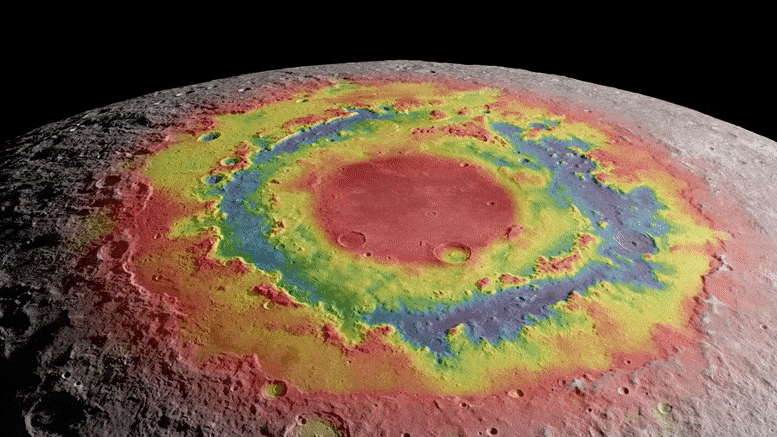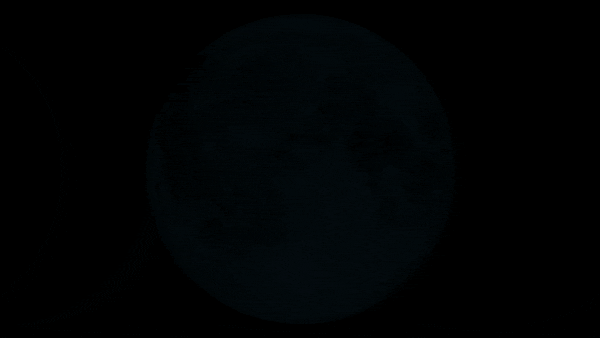Believe it or not, observing the Moon is something you can do no matter the weather, time of day, or location! We interpret “observe” very broadly. There are so many ways to celebrate and observe the Moon for International Observe the Moon Night. Here are ten of our favorites:
1. Look up

A first quarter Moon is ideal for observing. Credit: NASA’s Scientific Visualization Studio/Ernie Wright
The simplest way to observe the Moon is to look up. The Moon is the brightest object in our night sky, the second brightest in our daytime sky, and can be seen from all around the world — from the remote and dark Atacama Desert in Chile to the brightly lit streets of Tokyo. International Observe the Moon Night is always held near a first-quarter Moon, which means that the near side of the Moon is about half-illuminated. A first-quarter Moon is great for evening observing as it rises in the afternoon and is high above the horizon in the evening. With the naked eye, you can see dark gray seas of cooled lava called mare. Review our viewing guide for more tips on lunar observing!
2. Peer through a telescope or binoculars
With some magnification help, you will be able to identify details on the Moon. The line between night and day on the Moon (called the terminator) is ideal for seeing lunar craters and mountains since very long shadows heighten the contrast of the features. Check out the Moon Maps for some guided observing on Saturday.
3. Photograph the Moon

The Lunar Reconnaissance Orbiter Camera imaged this bright young ray crater in 2018. The image covers an area about 5 miles (8.1 kilometers) across. Credit: NASA/GSFC/Arizona State University
Our Lunar Reconnaissance Orbiter (LRO) has taken more than 20 million images of the Moon, mapping it in stunning detail. You can see featured, captioned images on LRO’s camera website, like the crater shown above. And, of course, you can take your own photos from Earth. Check out our tips on photographing the moon.
4. Relax on your couch

This clip of Orientale Basin was made with data from the Lunar Reconnaissance Orbiter by our Scientific Visualization Studio. Credit: NASA’s Scientific Visualization Studio/Ernie Wright
Is it cloudy? Luckily, you can observe the Moon from the comfort of your own home. The Virtual Telescope Project will livestream the Moon over Rome, Italy. Or, you can take and process your own lunar images with the MicroObservatory Robotic Telescopes. Would you prefer a movie night? In addition to the many films that feature our nearest neighbor, you can spend your evening with our lunar playlist on YouTube or this video gallery. You’ll learn about the Moon’s role in eclipses, look at the Moon’s phases from the far side, and see the latest science portrayed in super high resolution.
5. Touch the topography

Ina D is a volcanic landform on the Moon. Visual images, like the one on the left taken by LRO, present an optical illusion. The darker areas are raised and the lighter areas are depressions. Using topographic data, this 3D printed model on the right provides clarity. Credit: NASA GSFC/Jacob Richardson
Observe the Moon through touch! If you have access to a 3D printer, you can peruse our library of 3D models and lunar landscapes. This collection of Apollo resources features 3D print models of the Apollo landing sites using topographic data from LRO and the SELENE mission. On the Apollo 11 model, near the center, you can actually feel a tiny dot where astronauts Neil Armstrong and Buzz Aldrin left the Lunar Descent Module.
6. Make and admire Moon art
Enjoy artwork of the Moon and create your own. Submit photos of your artwork (paintings, poetry, sketches, jewelry) to our Flickr gallery, or share on social media using #ObserveTheMoon. We’ve got some tips for budding poets on composing a lunar haiku. Or do an art activity! For messy fun, lunar crater paintings demonstrate how the lunar surface changes due to frequent meteorite impacts.
7. Listen to the Moon
Sonification is the process of translating data into sound and music. In this musical data sonification of lunar knowledge and exploration, we can hear the progress made throughout the Apollo program to now as our understanding of the Moon expands. Listen to the percussion, which signifies launches and the passage of time. The pitch of the string and brass instruments conveys the amount of scientific activity associated with the Moon over time. Credit: NASA Explorers: Apollo/System Sounds
Treat your ears this International Observe the Moon Night. Several NASA podcasts feature lunar science, exploration, and history, including Houston We Have a Podcast from the Johnson Space Center, NASA Explorers: Apollo, which features personal stories from the Apollo era to now, and Gravity Assist with NASA Chief Scientist Jim Green. The third season is all about the Moon. If you prefer listening to music, make a playlist of Moon-themed songs. For inspiration, check out this list of lunar tunes. We also recommend LRO’s official music video, The Moon and More, featuring Javier Colon, season 1 winner of NBC’s “The Voice.” Or you can watch this video featuring “Clair de Lune,” by French composer Claude Debussy, over and over.
8. Take a virtual field trip
Plan a lunar hike with Moon Trek. Moon Trek is an interactive Moon map made using NASA data from our lunar spacecraft. Fly anywhere you’d like on the Moon, calculate the distance or the elevation of a mountain to plan your lunar hike, or layer attributes of the lunar surface and temperature. If you have a virtual reality headset, you can experience Moon Trek in 3D.
9. See the Moon through the eyes of a spacecraft

The Lunar Orbiter Laser Altimeter (LOLA) aboard LRO sends laser pulses down to the surface of the Moon from the orbiting spacecraft. These pulses bounce off of the Moon and return to LRO, providing scientists with measurements of the distance from the spacecraft to the lunar surface. This image shows the slopes (inclines, or hills) found near the south pole of the Moon. The bright red to white areas have the highest slopes (25 degrees or more) while the dark blue to purple areas have the smallest slopes (5 degrees or less). The largest slopes are found in impact crater rims, which appear as brightly colored circular features throughout the image. Credit: NASA/GSFC/MIT
Visible light is just one tool that we use to explore our universe. Our spacecraft contain many different types of instruments to analyze the Moon’s composition and environment. Review the Moon’s gravity field with data from the GRAIL spacecraft or decipher the maze of this slope map from the laser altimeter onboard LRO. This collection from LRO features images of the Moon’s temperature and topography. You can learn more about the different NASA missions to explore the Moon here.
10. Continue your observations throughout the year
International Observe the Moon Night is the perfect time to start a Moon journal. See how the shape of the Moon seems to change over the course of a month, and keep track of where and what time it rises and sets. To check your work, visit Dial-A-Moon, where you can plug in any date of the year to see the Moon phase. Observe the Moon all year long with these tools and techniques!
However you choose to celebrate International Observe the Moon Night, we want to hear about it! Register your participation and share your experiences on social media with #ObserveTheMoon or on our Facebook page. Happy observing!







